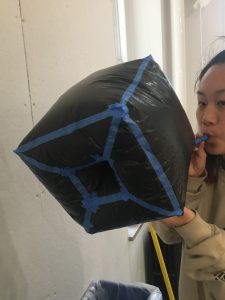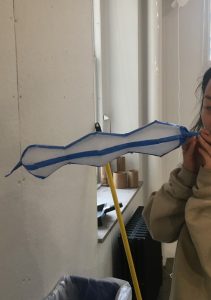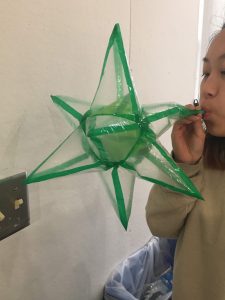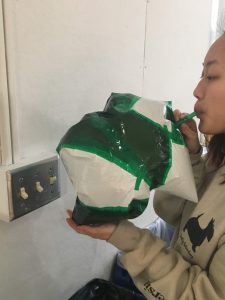Assignment 1: Improvisational Inflatables – Holly Liu
This assignment was very much an opportunity to learn through experimentation for me. I started making my forms after the second class, so I was very inspired by the geometric polyhedra we were constructing. I didn’t follow any particular plans for any of my forms, just making what I wanted to and learning through creation.
Hole Cube
My first form is the cube with the hole through the middle. The cube was very obviously inspired by the regular polyhedra we were working on during class; I didn’t have any particular reason for putting the hole through the middle other than that I wanted to. I found that using blue painter’s tape is good for creating corners when layered or creating some semblance of a sharp edge when creased, but is not sticky enough to properly hold the form together when inflated. I do think that using only quarter thicknesses of the tape contributed to the sharpness of the edges. However, it was extremely convenient to be able to easily tear the tape.

Abstracted Edamame Bean
The name was chosen after my friend compared the deflated form to her dinner. This form was created by folding a sheet of plastic in the style of a paper fan, cutting diagonally in alternating directions, and using those identical pieces to create the form. I tried to prevent leaks by double taping the seams but realized that the biggest issue was the tape itself.

Not-Abstracted Edamame Bean
This was an attempt to recreate the edamame bean form, but only using one piece of material. I ended up cutting triangles and diamonds out of the plastic and taped the edges together with yellow electrical tape on the inside of the form. I still tried to patch corners to prevent leaks, but I still struggled with getting the inflatable to not leak air.

Spiky Octahedron
My spiky octahedron was made because I liked the spiky ends of the edamame and wanted more of them. My original intention was to Stick the spikes onto each of the faces of the octohedron, but I realized partway through construction that if I attached the spikes directly to the octahedron as intended, they wouldn’t be able to inflate. I ended up offsetting the faces and the edges of the octahedron to the spikes and cut off the corners of the octahedron to allow air to flow through the octahedron and into the larger spikey form. I specifically chose the plastics so that the viewers can see through the spikes to see the entire structure of the construction.

Randomization
This construction was almost fully randomized. The plastic choices were the first two bags that I touched, the pieces were cut at random angles, mixed into a pile, and when making the form, I required myself to work with the first piece I touched, and worked with tape widths in the pattern of quarter, quarter, half. 